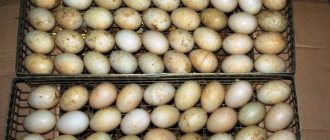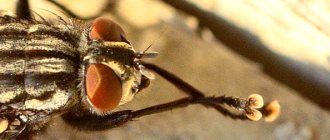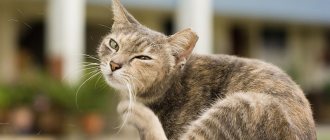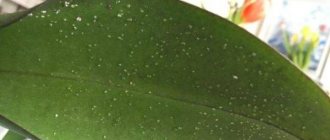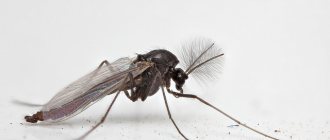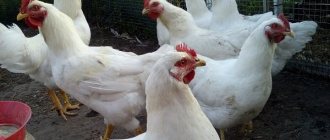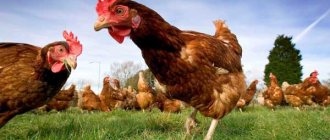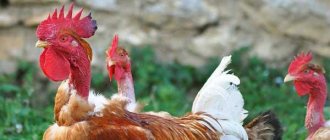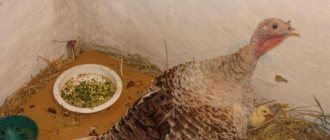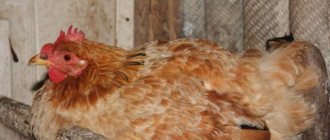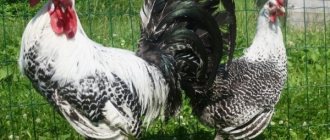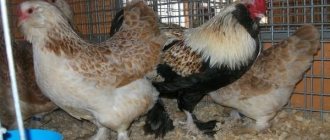1 604
no comments yet
0
Author:
Sadchikov Nikolai Alekseevich.
Reading time: 3 minutes
Pterophagy is a polyetiological disease of young and adult birds, which manifests itself with a lack of protein, a number of vitamins, minerals and amino acids. The first signs of the disease are eating fallen feathers, then plucking feathers from relatives on the back, from the tail and wings, and pecking at the paws.
Why do they eat? Causes
Chickens begin to pluck feathers due to improper feeding.
The body of birds lacks mineral salts and other useful substances. The first symptom of pterophagy is keratinized feathers. With reduced immunity, young animals need to add feather meal to their food.
This additional nutritional element normalizes the concentration of minerals in the chickens’ body.
Other causes of pterophagy are:
- lack of space in the chicken coop;
- bright lighting in the barn, which can provoke aggressive behavior in chickens;
- keeping regular and fighting breeds within the same premises.
If a poultry farmer notices bald areas around the chicken's cloaca, it is necessary to urgently examine the bird; perhaps its oviduct is injured. Bald patches on the back indicate a poor diet.
Poor nutrition
An incorrectly chosen diet for feeding chickens or a lack of basic nutritional components of poultry feed can cause feathers to be pulled out.
If the diet lacks protein, it can be replenished from the feathers that contain it. Using only grain feed causes a lack of amino acids containing sulfur, and vitamin deficiency appears.
The content of mycotoxins in feed causes diarrhea and inflammation of the anus. When chickens eat feathers, they compensate for the lack of trace elements in their food.
Excess protein is also undesirable. It leads to an imbalance in the acid-base balance. In this case, an incorrect exchange of phosphorus and potassium occurs, vitamin A is destroyed.
Chicken nutrition problems are solved as follows:
- the protein content is increased by adding meat and bone and fish meal, cottage cheese, and worms;
- add 0.1 grams of sulfur for each bird when molting;
- add 15 grams of methionine per 10 kilograms of feed;
- laying hens are given 0.5 grams of table salt;
- Among minerals, egg shells, shell rock, and pebbles are added to the feed.
Only by ensuring rational feeding can you get rid of pterophagy.
Crowding
When there are a large number of individuals in a limited space, fights always occur between them. This happens especially often when there are not enough feeders. Fighting in close quarters for food, chickens will peck at each other, pulling out feathers.
Remember that crowded housing causes stress, illness, weight loss and decreased egg production.
Even if the chickens are in the chicken coop only at night or in bad weather, for comfort it is necessary to place no more than 5 adults per 1 square meter.
Chickens under the age of one month can be kept together in groups of 20, up to 3 months - 15, from 3 to 6 months - 9 chickens. These birds do not like large flocks; a group of 20 units is the most optimal.
When installing a drinking bowl, its length is made at the rate of 2 centimeters per head, and for a feeder - 10. In winter, it is necessary to walk chickens in a pen or fenced yard.
Room illumination
Chickens have inherited from their wild relatives the ability to increase or decrease the intensity of egg production depending on the length of daylight hours. With an artificial increase in lighting time, laying hens begin to lay eggs better.
When raising chickens, and especially broilers, in the first few days after hatching, the light in the room should be turned on throughout the day.
This ensures better feed consumption, as well as intensive growth of young animals. After some time, the duration of daylight hours is gradually reduced.
Read more here about: Features of the light regime for broiler chickens and egg pullets, light calculator
Experienced poultry farmers say that intense artificial lighting makes birds aggressive, they begin to fight, eat feathers and skin of their rivals.
Seasonal molt
This is a natural process of changing plumage. Molting occurs in the fall and lasts for 4-5 months. This process is accompanied by the absence of oviposition.
Due to a lack of nutrients, the chicken begins to peck at its relatives. On large poultry farms, the non-productive period is reduced to 2 months.
Keeping incompatible breeds
Keeping different breeds within the same chicken coop often leads to the death of the planted young animals. It has been observed that birds with light plumage show aggression towards chickens with dark feathers.
Some time after replanting, they begin to peck at the feather cover of their neighbors, but it also happens the other way around. The poultry house owner must determine who started plucking feathers first and take appropriate action.
Microclimate in the chicken coop
The state of indoor air, temperature and humidity affect the mood of chickens and their behavior. A dry atmosphere with dust particles dries out the pen and makes it brittle. The body secretes a secretion for hydration. The smell of the secretion attracts the attention of the neighbors, causing them to attack cannibalism.
An uncleaned room where poultry is kept, lack of clean bedding, dirt and the smell of ammonia irritate chickens and cause them to become aggressive. They begin to tear out feathers and peck at each other, which makes the situation worse.
To create a favorable atmosphere in the chicken coop, you need to ensure its ventilation, which cleans the air and prevents dampness.
It is necessary to constantly change the litter, keep it clean, and prevent it from getting wet. Dry hot air is humidified by spraying water from a hose in a fine stream into the room.
Arrival of new individuals to the herd
When introducing new chickens into an already established community, socialization of newcomers is required. This is not an easy process, since the old-timers are not always hospitable. They attack the new arrivals. Most often, one, the most cocky individual, starts, setting an example for others.
In this case, carefully monitor the flock. The most aggressive chicken is placed in a cage, allowing new members to get used to it.
It is important not to exceed the size of the community by more than 20-30 individuals, to provide them with food and useful space.
Stress
Stress can be caused by the following reasons:
- Increased temperature in the chicken coop.
- Change of feeding diet.
- Transfer to another herd or premises.
- The presence of strangers.
These factors cause aggression; chickens begin to pluck each other’s feathers. It is important not to disturb the birds’ habitual way of life and to follow the rules for raising them.
Ectoparasites
Common parasites for chickens are:
- mites;
- lice;
- pereaters.
They suck blood and irritate the skin. Chickens become restless, aggressive, scratch themselves, tear out the feathers of neighboring individuals, and peck them until they bleed.
To avoid infection by parasites, perform the following actions:
- promptly clean the chicken coop from dirt, droppings, and contaminated litter;
- periodically spray walls and floors with disinfectants;
- Chickens are regularly inspected and, if pests appear, a course of treatment is carried out.
A sick bird is quarantined.
No walking
All of the above factors increase their influence if the bird is not allowed to walk (for example, in winter). Individuals have nothing to occupy themselves with, and from boredom they begin to get easily irritated.
Lack of drinkers and feeders
Congestion near objects of food and drink can give rise to a fight with ripping out feathers and more.
The essence of the problem
Cannibalism and pterophagy
Cannibalism is not an independent disease. This is a response to various factors.
Some of the reasons why chickens pluck feathers include:
- stress;
- insufficient diet;
- helminthic infestation;
- hormonal imbalance;
- improper care;
- crowding.
Any of the factors can lead to nervous system disorders and eating disorders. Birds begin to peck feathers and eggs. Fights often end in injuries.
The sight of blood provokes a scuffle among the other birds, who join the fight and peck the wounded chicken to death.
The predecessor of cannibalism is pterophagy: tearing out and eating feathers. The first signs of the disease are observed in chickens. Intensive growth forces them to obtain additional food. Dominant chicks pull feathers from the tails of weak relatives. As a result, feeding behavior shifts, which further manifests itself during times of stress.
Dangerous moments
It is necessary to constantly monitor the behavior of chickens. Dangerous periods are:
- chicks aged 7-12 days;
- juvenile feather change at 1.5-2 months;
- Roosters are 3 months old;
- seasonal molting;
- the appearance of new chickens in the poultry house;
- change in food supply.
Diagnosing the cause
Pterophagy negatively affects the appearance of affected birds.
The locations of plucking usually depend on the factors that influenced this phenomenon:
- When the food is unbalanced, birds peck feathers all over their bodies and eat fallen feathers from the ground. This situation is often provoked by molting, which requires the intake of larger quantities of certain substances, or by a high productive period in egg-laying hens;
- If there is a lack of protein, the birds are of gastronomic interest in the toes, skin and body of their neighbors. Pulling feathers is accompanied by severe damage to the body. Chickens may start eating eggs;
- during hierarchical clarification of relationships, adult chickens peck in the head area, aiming at the comb and earrings;
- If there are problems with the cloaca or oviduct, chickens, attracted by the smell of blood, peck at the cloaca.
Topography of cannibalism
You can independently determine the reason why adult hens or chicks peck each other until they bleed by looking at the area of damage:
- Pecking of the head with injury to the comb and earrings. It occurs when a hierarchy is established, when young individuals, a new hen or rooster are added to the old flock.
- Plucking feathers on the back and tail area . It is a sign that chickens are lacking vitamins, minerals or amino acids in their diet.
- Pecking the skin until it bleeds . The main reason is a chronic lack of nutrients due to an unbalanced diet.
- Pecking of toes . It occurs against the background of allergic dermatitis, which is often caused by feed contaminated with mycotoxins. Pecking of limbs in chickens is also often observed during the period of active growth with unbalanced feeding and protein deficiency in the diet.
- Pecking of the cloaca . Occurs under intense lighting in the chicken coop. In pullets at the beginning of oviposition, blood vessels are clearly visible when the cloacal ring is tense. Chickens that lay large eggs often experience damage or even prolapse of the cloaca. Such an individual becomes the object of attention for other birds in the flock.
Treatment of sick individuals
To prevent birds from showing aggression towards each other, the following drugs can be administered to the birds’ food:
- "Methionine." The medicine is given at the rate of 4 tablets per kilogram of feed. This substance contains sulfur, vitamins, protein and mineral salts. Periodic consumption of “Methionine” helps improve the digestion process in chickens. The duration of treatment is 2 weeks.
- Fish fat. It is mixed with food at the rate of 100 grams of the substance per kilogram of food.
- Ascorbic acid solution. They can be given to birds for prevention. The dosage is calculated as follows: 2 tablets per liter of water.
- The drug "Chiktonik". It is added to water: 1 ml/l is enough for chickens, 2 ml/l for adults. The duration of feeding chickens is 7 days.
- "Vitvod" - the drug strengthens the immune system and increases the productivity of chickens. Contains vitamins A, D3, E. Used as injections or as a drink;
The bird loses its plumage due to lack of calcium.
A folk remedy for preventing pterophagia is the addition of crushed egg shells, crushed shells and chalk to food. In the summer, the livestock must be sent to pasture. The bird receives the maximum amount of nutrients in a field with alfalfa.
The following measures are also being taken:
- Organize normal lighting at the rate of 1 light bulb of 60–70 watts per 10 sq. m. Daylight hours should be in the range of 12.5–14 hours;
- Make sure that for 1 sq. m accounted for 4 individuals;
- Provide the poultry house with the required number of feeders and drinkers according to the standards;
- More often organize bird walks in the fresh air in places with green grass;
- Ventilate the room well, but without drafts;
- Hang brooms of nettles or tops, heads of cabbage around the chicken coop;
- Place baths of ash containing sulfur and sand;
- The most ardent instigators of fights are placed separately, otherwise pecking will be constantly provoked by them;
- Birds that have received wounds from pecking should also be isolated from the flock and their wounds disinfected. Damaged areas are treated with the following preparations - penicillin or ichthyol ointment, tincture of iodine containing glycerin.
Prevention
The best method to prevent pecking is to follow the rules for feeding and keeping the livestock.
The bird should not start fights for a place next to the feeder or drinker. The container into which food is poured, having a diameter of 50 cm, should not contain more than 50 adult chickens. For nipple drinking - 1 nipple per 10 chickens.
Using infrared lamps instead of conventional ones helps to significantly reduce the risk of pecking. If the problem already exists, then it is recommended to leave the chickens without light at all for some time. It is only included for feeding.
A lack of calcium also leads to the occurrence of pterophagy, and therefore birds need to place containers with feed chalk, shell rock, charcoal in the room and do not forget to give curd products.
What to do with an injured chicken?
Photo of a plucked chicken:
Birds affected by pterophagy are placed in a separate room. Minor damage is treated with a solution of hydrogen peroxide or furatsilin. Large wounds are lubricated with brilliant green, ointments: Sintomycin, Tetracycline, Levomekol.
Improve nutrition by increasing the dose of protein and vitamins. The individual is returned after complete recovery. At the same time, they monitor the behavior of chickens in the flock so that attacks do not happen again.
Lighting mode
The development of cannibalism is influenced by the lighting of the chicken coop. Bright light causes aggression in birds. It is recommended to use dim lighting and reduce the flow intensity. If the windows of the chicken coop get direct sunlight, then the windows are painted over with white paint. It is recommended to use infrared lamps or devices with a daylight effect.
For chickens, the light is not turned off either at night or during the day. The duration of daylight is reduced gradually, starting from 2 weeks. Turning off the electricity in the coop at night will cause stress to the chicks. Aggression will develop. The stronger chicks peck the weaker ones.
More on the topic: What to do to prevent chickens and roosters of the Ayam Tsemani breed from fighting?
The optimal length of daylight for adult laying hens is 14-16 hours. Changing the day disrupts metabolism and egg laying. With a sharp increase in egg production, the oviduct may be damaged. It falls out. The chickens peck at it. There is a bloody wound around the cloaca.
How to prevent pterophagia?
Loss of plumage in hens and chicks should alert the poultry farmer. Aggressive birds often peck their relatives until they bleed. To prevent this from happening, you need to make changes to your diet.
Sick chickens also show other signs of vitamin deficiency - a decrease in egg production, trembling in the body, and a decrease in muscle activity.
The following products will help replenish vitamins:
- alfalfa, corn grain or peas;
- meat and bone or fish, as well as feather meal;
- yeast, sunflower cake, chopped herbs;
- dairy products.
If a poultry farmer discovers that chickens are pecking each other’s feathers, he must adjust the birds’ diet and separate the most aggressive individuals from the flock. When calculating the usable area, it is necessary to place no more than 4 individuals on each square meter of the barn.
To prevent pterophagy, large poultry farms practice cage keeping of chickens. Birds of the same breed and age are placed in each block.
Another method to prevent the development of the disease is to reduce the duration of natural light to 16 hours a day.
Other preventive measures:
- in winter, so that the birds do not get bored and fight, grains (wheat, millet, corn, etc.) are scattered into the straw. The chickens' attention is focused for a long time on finding and consuming such food;
- monitor the density of the chicken coop, avoid crowding;
- observe the behavior of the flock and promptly send overly aggressive individuals to slaughter;
- you can purchase an authoritative rooster for your chickens so that he can keep order in the chicken coop;
- Keeping chickens in cages can eliminate pterophagy. Birds of the same breed and age should be selected for one family, so that more mature chickens do not offend the children;
- reduce the brightness of the light. To do this, the light bulbs are painted red or blue. The duration of daylight hours should not exceed 16 hours. Turning the lights on and off in winter should occur at the same time;
- When introducing newcomers to the chicken coop, you can use a trick - drop the new residents at night, on a walk, or make them a temporary fence with mesh so that they get used to them. The entry of new birds into the flock must be controlled;
- notice wounds and injuries in a timely manner, treat them so that they do not attract attention with the smell of blood;
- Sometimes large poultry farms use debeaking - this is cutting off the beak by 1/3. This procedure is carried out on chickens in the first days of life, as well as at the age of 1–2 months.
Seasonal molt
It is easy to distinguish natural loss of plumage from disease: when molting, the outer cover is renewed, so small feathers fall out from the lower layers. Chickens go bald gradually, the plumage retains its color and silkiness. Seasonal molting occurs over 1–2 months in a certain order:
- Head.
- Neck.
- Breast.
- Back.
- Wings.
- Sides.
- Tail.
Alarming symptoms of alopecia appear when the bird is not properly cared for. A chicken can become mangy at any time of the year. Large feathers become fragile, discolored, and fall out locally or in several areas at the same time.
If your chicken starts losing feathers, don't panic! First you need to make sure that it is not shedding. Seasonal molting is a natural process of feather renewal in a bird. Feathers are changed strictly in order:
- head;
- neck;
- breast;
- back;
- wings;
- sides;
- tail.
Moulting in poultry depends on age and season. In the spring, molting begins only in young chickens; the rest of the birds molt in the fall. This process lasts four to eight weeks.
Chickens peck each other's tail feathers. Why?
At first, eating feathers could be caused by a lack of protein and calcium in the body. Moreover, this period could be short-lived - during active egg production or molting. After this, the balance of calcium, other mineral components and protein can be restored, but the pecking habit will remain. In other words, a temporary lack of these and other nutritional components can cause a bad habit (often for life) of feather plucking. Therefore, at these critical moments in the life of birds, you need to ensure that their feeders have plenty of shells or other calcium-containing minerals and protein feeds: meat and bone or fish meal, boiled fish and meat waste, crushed peas, green mass of legumes (alfalfa, clover , peas), and in winter – their leaves or chopped hay.
In winter, to these probable reasons for feather pecking, crowding and cramped conditions in the chicken coop are added. And, surprisingly, the birds are bored and idle.
To eliminate this bad habit, you need to distract the bird and force it to do something. In winter, even in slight frosts, it is advisable to let her out into the yard or pen for at least a few hours. And in the chicken coop itself, scatter some grain into the litter so that the chickens rake it up and look for food. You can also prepare baskets of sunflowers and also give the bird the opportunity to do the “business”. Place cut zucchini, pumpkin, beets, hang sorghum panicles, brooms of nettles, mulberries and other herbs and tree branches.
Keep your chickens occupied with these “things” during the day, and they will not have time to pay attention to each other and engage in “undressing” their friends in the chicken coop.
Give them this photo. Switch their attention...
Chickens plucking feathers (video)
Monitoring the composition of a bird’s diet means taking care of its productivity. After all, a good laying hen can produce up to three hundred eggs a year! The composition of the feed must be completely balanced so that the chickens do not experience hunger, a lack of an important element that affects the processes in the body and the level of intensity of egg laying of chickens. Fiber, feed that is of animal origin and also contains large amounts of protein and calcium, is the key to success in poultry farming. Even if the chickens are kept in hanging cages, a complete diet will always ensure proper feeding, and hence the production of high-quality products.
When chickens roam freely at home and are not restricted in movement, they independently provide themselves with all the vital and necessary nutrients. In a cage, or when kept in a pen, all this must be provided to them, and of sufficient quality, forcing them to work for the benefit of their owners. In this case, success is always guaranteed, and you can count on full dedication from the hens.
Control measures
To prevent cannibalism in a chicken flock, the following measures should be taken:
- Provide moderate lighting intensity using a lux meter.
- Calculate how many birds the chicken coop can accommodate. Avoid crowding. The presence of a rooster in the flock does not affect the tendency of chickens to pterophagy.
- Ensure optimal feeding front.
- What to do if you find an aggressive bird? She needs to be kept away for several days. If the bad habit appears again, the offender is discarded.
- Use feed intended for the appropriate type and age of poultry. A poultry farmer who has his own grain can reduce the cost of food by using BVMK, for example, a product from the Russian one. It is impossible to prepare a feed mixture, which is not inferior in nutritional value to industrial feed, from individual ingredients in a household environment. You can use separate feeding of energy and mineral components. The bird eats the shell with pleasure if you put it in a separate feeder.
- De-bobbing. The operation involves trimming the sharp tip of the beak. The bird loses its ability to peck, but manipulation does not affect its food consumption. Debicing is carried out at poultry farms, but an amateur poultry farmer can purchase raised chickens.
